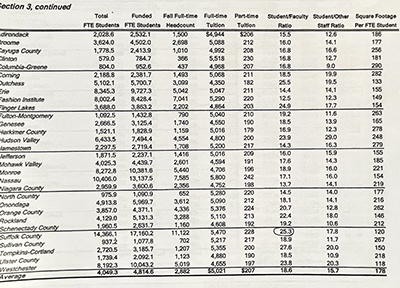Dante Morelli
The Faculty Association has reached a new high and a new low. It's an unfortunate ratio. For the first time in our union’s history, the percentage of full-time faculty currently stands at a mere 27% of our membership. Our adjunct colleagues comprise the other 73%. Some statisticsTen years ago, at the start of the fall 2012 semester, there were 476 full-time FA members—which includes classroom faculty, professional assistants, counselors, librarians, specialists and coordinators. Of this 407 in our current full-time membership, only 238 are classroom faculty. At a college with a headcount hovering around 15,000 students, this is clearly too few full-time classroom faculty. SUNY’s 2020-21 annual report summary for community colleges notes that our student-to-faculty ratio is 25.3:1, which is the third largest in the state. For comparison, in 2020-21 Nassau Community College had a ratio of 17.1:1, Westchester 23.8:1 and Monroe 18.9:1. Unfortunately, our full-time membership numbers are expected to continue to decrease with upcoming retirements, as we have heard upper administration acknowledge their intent to continue to rely on “savings by attrition.” By fall 2023, our full-time faculty member total could be under 400. It is clear that our full-time faculty are not being replaced at the same rate as adjuncts are being hired. Since December 1, 2021, more than 90 adjuncts have been hired at the college. It’s important to note that not a single person serving in the administration at the college is working part time. They all enjoy full-time salaries and benefits. Questions being raisedThe question of our full-time-to-adjunct faculty ratio was raised at the Suffolk County Legislature’s Education and Labor Committee meeting on October 7, 2022. I attended this meeting, and Legislator Dominick Thorne asked SCCC President Bonahue and SCCC Board of Trustees Chairman Chris Murray about the full-time-to-adjunct ratio. Unfortunately, our administrative leadership did not know the answer to this important question but did have responses prepared for why the president received a 13% raise after one year of service. Sitting in the audience, I immediately sent a text to Education & Labor Committee Chairman James Mazzarella and to Presiding Officer Kevin McCaffrey to notify them of our current full-time-to-adjunct ratio. The Legislature has been sensitive and responsive to the problem of how the college runs our three campuses on the backs of adjunct faculty, so I was happy to see them address this issue with administrative leadership. Since that October 7 meeting, I have interacted with six county legislators about the president’s raise—naturally, numerous questions have come to us from our membership regarding that as well—and about the college’s unhealthy overreliance on adjunct faculty. Fortunately the Legislature seems to recognize the legitimate concerns that we have with this imbalance. To be fair, we believe that college administration recognizes this too, but we need to see real action. In this critical time in the history of the college, we need more genuine, open, good faith collaboration than ever to better access, serve, retain and graduate students appropriately and successfully. As a step toward this, I felt obliged to address the Board of Trustees at their October 20 meeting. I made it clear, on the record, both the raw numbers and percentage of full-time faculty to adjunct faculty. A matter of fairness and equityI want to be clear that we know our adjunct faculty make important contributions to our students during their time at the college. We know that while their labor here is part time, their hearts are in the work full time. We know research points to inferior working conditions, not inferior instructional practices, as contributing to some of the negative outcomes caused by overreliance on adjunct classroom faculty. We always have been and continue to be grateful for the good work of our adjunct colleagues. But we also know while that the full-time/adjunct imbalance will not change any time soon, we must address it in very real ways right now. It's a matter of fairness and equity. The current imbalance is unfair to our members. How is it fair and equitable at a teaching institution that the bargaining unit that represents classroom faculty—literally the people doing the teaching at a college—is being adjunctified but administrators and others are not? The current imbalance is also an injustice to our students. They deserve faculty in their classrooms who are fully engaged in the life of the college, hold five or more office hours each week, shape the curriculum being carried out in those classrooms, participate in lively debates in our department and governance meetings and are simply able to be more fully present for our students. This full-time engagement is critical to the future of the institution. We know that our student population is growing increasingly diverse, not just demographically but also academically. We are one of the most diverse community colleges in the state outside of NYC, and we recently achieved the federal designation of being an Hispanic Serving Institution (HSI). Especially post-pandemic, our students need more support both in and out of the classroom than ever before. As we step into contract negotiations with administration, our members have our commitment that we will make this simple point clear, again and again, to administration: This new low has got to go. |
